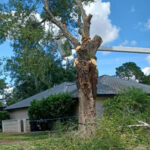In Florida, the best time to remove a tree depends on the species and the reason for removal. In general, it’s best to avoid removing trees during the growing season, which is typically from spring to fall. This is because during this time, the tree is actively producing new growth and removing it can be more stressful and damaging to the tree.
The best time to remove a tree in Florida depends on several factors such as the type of tree, its health condition, and the reason for removal. In general, it is best to remove trees during their dormant period, which is usually during the cooler months from late fall to early spring. This is because the cooler temperatures and reduced sunlight during this time can minimize stress on the tree and make it easier to remove.
However, in Florida, the weather is relatively mild year-round, and some tree species may not have a specific dormant period. For example, palm trees are commonly found in Florida and they do not have a distinct dormant period. In this case, it may be best to remove the tree when it is showing signs of decline, such as yellowing or wilting leaves, or when it poses a safety hazard, such as leaning or having weak branches.
It is important to note that tree removal should be done by a professional arborist or tree service, as it can be dangerous and requires specialized equipment and training. Additionally, there may be local regulations or permits required for tree removal in certain areas, so it’s always best to check with your local government before removing a tree.
In any case, it’s always best to consult with a certified arborist who can assess the tree and provide recommendations on the best time for removal, as well as the best techniques to use.
When is the best time to trim trees in Florida?
The best time to trim trees in Florida depends on the type of tree you are trimming. Generally, it’s recommended to trim trees during their dormant season, which in Florida typically occurs from late fall to early spring. During this time, the trees have lost their leaves, making it easier to see the structure and make necessary cuts. Pruning during the dormant season can also reduce the stress on the tree and help to prevent the spread of disease.
However, there are some exceptions. For example, some species of trees such as live oaks and magnolias should be trimmed in mid to late summer to avoid attracting beetles that may carry oak wilt disease.
It is also important to avoid trimming trees during the hurricane season, which runs from June 1 to November 30, to avoid causing additional stress to the tree.
If you are not sure when to trim your trees, it is best to consult with a certified arborist who can provide advice specific to your tree species and location.
However, some trees, such as oaks, should not be trimmed during the dormant season because they are susceptible to oak wilt, a fungal disease that can spread through pruning cuts. For oaks and other trees with similar vulnerabilities, it’s best to consult with a certified arborist to determine the best time for trimming.
Contact Advanced Arborist today for a free estimate from a Certified Arborist!




